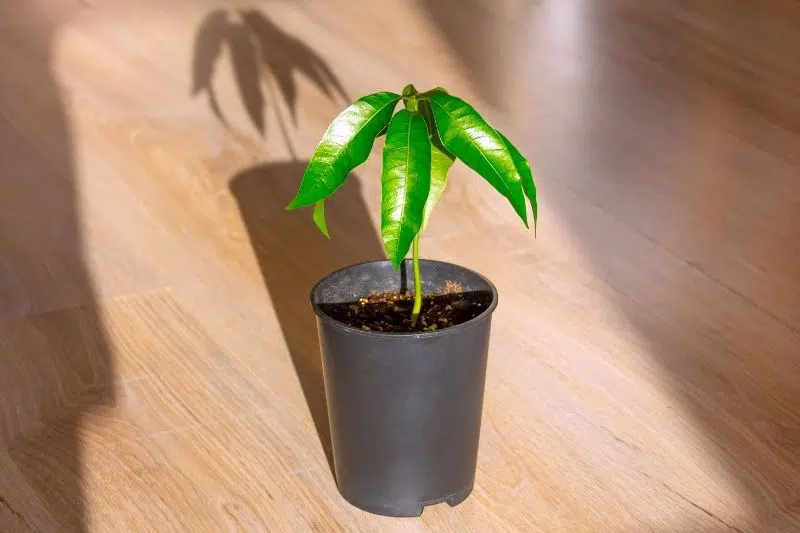If the decorative mango plant gets brown leaves, then this may have several causes. We tell you how to properly respond to brown spots and save the plant.
- brown spots on mango leaves often indicate sunburn
- dark or wilted shoots indicate spider mites
- anthracnose fungus causes brown or black leaves/spots
- wet brown spots on the leaves are caused by bacteria
- incorrect fertilization often promotes brown leaves or spots
Contents
Avoid sunburn
The leaves of the mango are sensitive to the sun’s rays. Especially with indoor plants, sunburn can therefore occur quickly. Then brown spots appear on the leaves, which can no longer be reversed. It is nevertheless advisable to choose a different location:
- bright, but without direct sunlight
- do not place directly behind window glass
- darken in case of blazing sunlight, e.g. by blinds or curtains
- in the conservatory or greenhouse, also watch out for too much sunlight
- sun rays often penetrate through a glass roof.
Note: For a more attractive appearance, remove burnt brown leaves on the mango plant. If you change the location or take other measures against direct sunlight, new leaves will grow back without spots.
Control spider mites
If the plant stands too dry and does not receive enough humidity, then an infestation of spider mites will quickly occur. These pests can also be the cause of brown spots forming on the leaves of the mango plant. However, spider mites are mainly recognized by the wilted and black shoots and should then be controlled:
- Thoroughly rinse off pests
- Permanently increase humidity
- Spray the plant regularly with water
- remove infested shoots and leaves
- as a last alternative use insecticide against the mites
Note: Since mango plants originated in the tropics, they prefer high humidity and plenty of heat. Unfortunately, this combination also provides a good breeding ground for many pests and viruses.
Anthracnose fungus
One fungus that frequently attacks mango plants is the anthracnose fungus. On plantations, the trees are therefore sprayed with a fungicide before budbreak to prevent the fungal disease from occurring in the first place. Infection with the pathogen Colletotrichum gloeosporioides is particularly favored by wet weather. In order to prevent fungal infestation of your own mango plant in the first place, the following should be observed:
- Keep only as a houseplant in local latitudes.
- do not place the plant too close to other plants
- so air can circulate
- leaves will dry up even with high humidity
- remove and dispose of leaves infected by the fungus
- use fungicides if necessary
Tip: A good solution against fungal infestation is also a mixture of two tablespoons each of cooking oil and baking soda to one liter of water. Put this in a spray bottle and spray the infested plant as well as the soil all around with it.
Check fertilization
If brown, dry spots form on the leaves of the mango plant, then the fertilization should be checked if a fungal infection or disease can be ruled out. Indeed, in this case, overfertilization with too many salts or even nitrogen may have occurred. For it is quite recommended to fertilize the plant also with bitter salts. To save the mango then, the following further procedure is recommended:
- remove all infested leaves
- remove the tree from the container
- remove all soil from the roots
- wash out the old pot well
- choose fresh substrate
- reinsert mango and water well
- do not fertilize for the first time
Tip: For the future, choose an appropriate fertilizer that contains less salts and nitrogen. Be sure to also administer this according to the manufacturer’s instructions for dosage and frequency of administration.
Frequently asked questions
Are fruits with black spots still edible?
Mango fruits with brown or black spots should be enjoyed with caution. This is because the fruits of the mango tree do not start rotting from the stalk like other fruits. The black dots and spots are incipient rot. Depending on how far this has progressed, you should refrain from eating the fruit.
The spots on the leaves of my mango are dark and oozing – why?
If not only are there brown spots on the leaves, but they are also weeping and rotting in appearance, then it is a bacterial infestation. This bacterial leaf spot disease is caused by the bacterium Xanthomonas campestris pv. mangiferaeindicae and can cause the mango to die if you do not use appropriate chemical treatments to combat it.
Is there anything I can do to prevent a fungal infection on my mango?
Fungicides, ideally copper-based, are sprayed as a preventative. However, this can reduce fruit quality. Therefore, use sparingly or only when you are not concerned with an abundant crop. The fungicide is sprayed once a week before flowering and protects the leaves from fungal attack.


